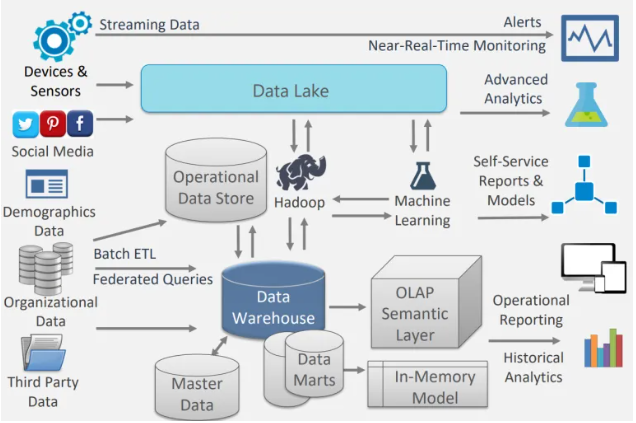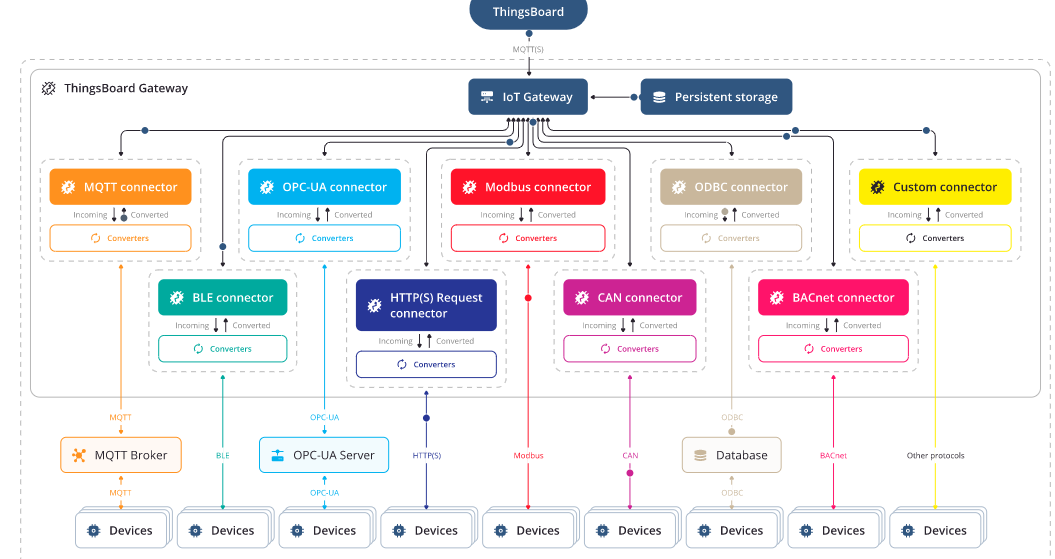A Data Warehousing (DW) is process for collecting and managing data from varied sources to provide meaningful business insights. A Data warehouse is typically used to connect and analyze business data from heterogeneous sources. The data warehouse is the core of the BI system which is built for data analysis and reporting.
Figure 1:
Data Warehouse

Data warehouse is needed for all types of users like: - Decision makers who rely on mass amount of data. - Users who use customized, complex processes to obtain information from multiple data sources. - It is also used by the people who want simple technology to access the data - It also essential for those people who want a systematic approach for making decisions. - If the user wants fast performance on a huge amount of data which is a necessity for reports, grids or charts, then Data warehouse proves useful. Data warehouse is a first step If you want to discover 'hidden patterns' of data-flows and groupi
In a market saturated with apps, social media platforms, analytics tools, and pay-per-click campaigns, we can help small businesses figure out if the marketing strategy they've invested in is producing ROI (return on investment). We can help you create analytics reports where businesses can base decisions on solid research, data, and facts, rather than intuition, assumption, or gut instinct. How do you know something is working? Reports can tell you a much bigger story than you could imagine.
Data Warehouse Modernization
Modernizing your Data Warehouse on AWS supports rapid growth development and run quick analytics from multiple sources. Data Warehouse Modernization people to ask and answer inquiries of your data progressively with the adaptability of Tableau. Vtecs Holdings provides a complete platform to a data warehouse.
In-Database Advanced Analytics
No longer wait for queries to load data with in-database advanced analytics solutions. Analyze information and make real-time on ongoing decisions to gain a competitive advantage over your rival. Scale up your data preparation with In-Database Processing. Vtecs Holdings offers advanced and ever growing set of advanced in-database analytics and Machine Learning algorithms to conduct the analytics computations closer to the data.
Big Data Warehousing Solutions
Easily migrate Data Warehouse Workloads to Apache Hadoop with Data Warehouse Workload Migration Solutions. Speed up versatile SQL Processing utilizing Apache Hadoop. Reduce the risk of migration with automated QA checks. Vtecs Holdings offers advanced Data Science Machine Learning algorithms for enhanced data quality.
Data Warehouse Modernization Solutions
Quickly create large data sets with little or no changes to existing process. Add new analytics at a fraction of a cost unlike in traditional Data Warehousing Solutions. Replace traditional ETL approach with a modern self-service driven approach. Manage huge volumes of data at Exabyte Scale. Deliver Faster Analytics. Integrate with existing BI, ETL Tools Eliminate Data Silos. Big Data and Advanced Analytics Ready Data Warehouse Environment.
The Internet of Things, or IoT, refers to the billions of physical devices around the world that are now connected to the internet, all collecting and sharing data. Thanks to the arrival of super-cheap computer chips and the ubiquity of wireless networks, it's possible to turn anything, from something as small as a pill to something as big as an aeroplane, into a part of the IoT. Connecting up all these different objects and adding sensors to them adds a level of digital intelligence to devices that would be otherwise dumb, enabling them to communicate real-time data without involving a human being. The Internet of Things is making the fabric of the world around us more smarter and more responsive, merging the digital and physical universes.
Figure 2:
Internet of Things

Organizations best suited for IoT are those that would benefit from using sensor devices in their business processes.
Manufacturing
Manufacturers can gain a competitive advantage by using production-line monitoring to enable proactive maintenance on equipment when sensors detect an impending failure. Sensors can actually measure when production output is compromised. With the help of sensor alerts, manufacturers can quickly check equipment for accuracy or remove it from production until it is repaired. This allows companies to reduce operating costs, get better uptime, and improve asset performance management.
Automotive
The automotive industry stands to realize significant advantages from the use of IoT applications. In addition to the benefits of applying IoT to production lines, sensors can detect impending equipment failure in vehicles already on the road and can alert the driver with details and recommendations. Thanks to aggregated information gathered by IoT-based applications, automotive manufacturers and suppliers can learn more about how to keep cars running and car owners informed.
Transportation and Logistics
Transportation and logistical systems benefit from a variety of IoT applications. Fleets of cars, trucks, ships, and trains that carry inventory can be rerouted based on weather conditions, vehicle availability, or driver availability, thanks to IoT sensor data. The inventory itself could also be equipped with sensors for track-and-trace and temperature-control monitoring. The food and beverage, flower, and pharmaceutical industries often carry temperature-sensitive inventory that would benefit greatly from IoT monitoring applications that send alerts when temperatures rise or fall to a level that threatens the product.
Retail
IoT applications allow retail companies to manage inventory, improve customer experience, optimize supply chain, and reduce operational costs. For example, smart shelves fitted with weight sensors can collect RFID-based information and send the data to the IoT platform to automatically monitor inventory and trigger alerts if items are running low. Beacons can push targeted offers and promotions to customers to provide an engaging experience.
Public Sector
The benefits of IoT in the public sector and other service-related environments are similarly wide-ranging. For example, government-owned utilities can use IoT-based applications to notify their users of mass outages and even of smaller interruptions of water, power, or sewer services. IoT applications can collect data concerning the scope of an outage and deploy resources to help utilities recover from outages with greater speed.
Healthcare
IoT asset monitoring provides multiple benefits to the healthcare industry. Doctors, nurses, and orderlies often need to know the exact location of patient-assistance assets such as wheelchairs. When a hospital’s wheelchairs are equipped with IoT sensors, they can be tracked from the IoT asset-monitoring application so that anyone looking for one can quickly find the nearest available wheelchair. Many hospital assets can be tracked this way to ensure proper usage as well as financial accounting for the physical assets in each department.
General Safety Across All Industries
In addition to tracking physical assets, IoT can be used to improve worker safety. Employees in hazardous environments such as mines, oil and gas fields, and chemical and power plants, for example, need to know about the occurrence of a hazardous event that might affect them. When they are connected to IoT sensor–based applications, they can be notified of accidents or rescued from them as swiftly as possible. IoT applications are also used for wearables that can monitor human health and environmental conditions. Not only do these types of applications help people better understand their own health, they also permit physicians to monitor patients remotely.
We offer to our clients a range of the top Technologies meet their needs in the IoT field which include:
- Create new efficiencies in manufacturing through machine monitoring and product-quality monitoring. Machines can be continuously monitored and analyzed to make sure they are performing within required tolerances. Products can also be monitored in real time to identify and address quality defects.
- Improve the tracking and “ring-fencing” of physical assets. Tracking enables businesses to quickly determine asset location. Ring-fencing allows them to make sure that high-value assets are protected from theft and removal.
- Use wearables to monitor human health analytics and environmental conditions. IoT wearables enable people to better understand their own health and allow physicians to remotely monitor patients. This technology also enables companies to track the health and safety of their employees, which is especially useful for workers employed in hazardous conditions.
- Drive efficiencies and new possibilities in existing processes. One example of this is the use of IoT to increase efficiency and safety in fleet management. Companies can use IoT fleet monitoring to direct trucks, in real time, to improve efficiency.
- Enable business process changes. An example of this is the use of IoT devices to monitor the health of remote machines and trigger service calls for preventive maintenance. The ability to remotely monitor machines is also enabling new product-as-a-service business models, where customers no longer need to buy a product but instead pay for its usage.
Thank you! Your information has been well-received. Our support team will contact you within 1 hour !

Contact Us!
Our support team usually responds in 12 hours or less.


